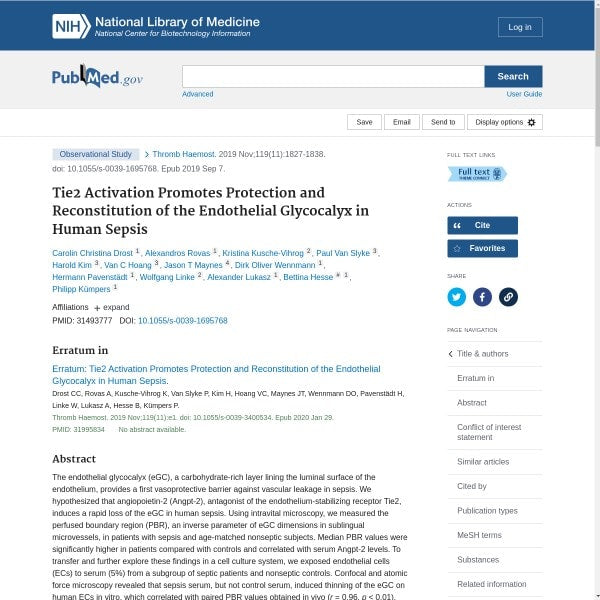
Tie2 Activation Promotes Protection and Reconstitution of the Endothelial Glycocalyx in Human Sepsis
Share

Abstract
The endothelial glycocalyx (eGC), a carbohydrate-rich layer lining the luminal surface of the endothelium, provides a first vasoprotective barrier against vascular leakage in sepsis. We hypothesized that angiopoietin-2 (Angpt-2), antagonist of the endothelium-stabilizing receptor Tie2, induces a rapid loss of the eGC in human sepsis. Using intravital microscopy, we measured the perfused boundary region (PBR), an inverse parameter of eGC dimensions in sublingual microvessels, in patients with sepsis and age-matched nonseptic subjects. Median PBR values were significantly higher in patients compared with controls and correlated with serum Angpt-2 levels. To transfer and further explore these findings in a cell culture system, we exposed endothelial cells (ECs) to serum (5%) from a subgroup of septic patients and nonseptic controls. Confocal and atomic force microscopy revealed that sepsis serum, but not control serum, induced thinning of the eGC on human ECs in vitro, which correlated with paired PBR values obtained in vivo (r = 0.96, p < 0.01). Inhibition of Angpt-2 or Tie2 activation completely abolished eGC damage. Mechanistically, sepsis-induced eGC breakdown required the loss of its main constituent heparan sulfate; a result of heparan sulfate-specific enzyme heparanase, which was suppressed by Tie2 activation. Finally, Tie2 activation, but not Angpt-2 inhibition, initiated after septic or enzymatic damage provoked rapid refurbishment of the eGC. Our data indicate that eGC breakdown in human sepsis is mediated via Tie2 deactivation by Angpt-2. Activation of Tie2 seems to accelerate recovery of the eGC and might hold promise as a therapeutic target in human sepsis.
